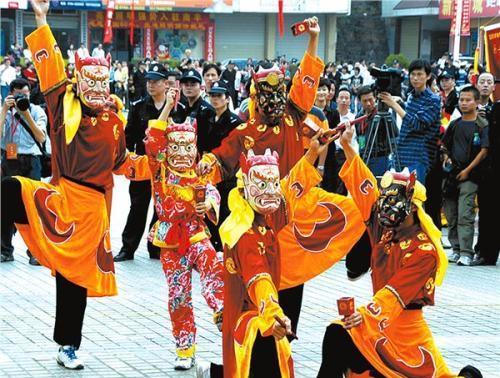The Spring Festival is the most solemn traditional festival of our Chinese nation, and the Spring Festival contains profound cultural connotations in the inheritance and development from ancient times to the present, and has always carried a rich historical and cultural heritage in the inheritance and development.
So, do you know how the Spring Festival of the Tang Dynasty was spent, and what is the difference between it and our Spring Festival today?
Today, let's first understand how ordinary people in the Tang Dynasty spent the Spring Festival.

In ancient China, the New Year contained people's wishes to drive away ghosts and demons, ensure peace and pray for peace, and "nuó" is a ritual that epitomizes this role.
In the Chinese New Year's Eve night of the ancient Chang'an City, there were often encounters with exorcism brigades on the street, this form lasted for thousands of years in ancient times, and even in modern times, there are still similar activities in some villages in China.
Usually there is a pair of men and women in front of them, wearing the masks of the old man and the old woman, leading the dance, and their roles are called the two men and the mother, and behind them, there are a thousand children and eight hundred people wearing children's masks, called the zhèn son.
The others are wearing various ghost masks and acting as villains. Everyone danced while walking, playing and singing, most of them mainly joined in the fun, and the front professional leader had lyrics, mostly describing how righteous humans drive away ghosts.
In the Tang Dynasty, firecrackers with gunpowder did not appear, so when firecrackers were released, children would throw bamboo poles into the fire. There is air in the middle of the bamboo pole, and when it is burned by fire, it will make a "crackling" sound, which sounds similar to the sound of firecrackers we set off today.
When the hour came, at this moment of greeting the old and welcoming the new, the bells and drums on the street sounded in unison. The elderly people in the family got up one after another, the juniors saluted the elders, and the slaves kowtowed to the masters.
The words of mutual greetings to each other are not our "Wishing you prosperity" today, and the simple New Year's greetings of the Tang Dynasty are usually "Fuyan New Day, Celebrating Life Without Boundaries", "Fuqing Chuxin, Shoulu Extension" and so on, but in the Tang Dynasty, there was no pressure on the old age money.
The first day of the Tang Dynasty's New Year is called Yuan Day, which can also be called New Year's Day, but it has a different meaning from the new year's Day of the first day of the first month of the Gregorian calendar.
In the early morning of this day, people would erect a long, long bamboo pole in the courtyard, the bottom of which was buried in the soil, and a long flag made of paper or cloth was hung on the top of the pole to pray for a long life.
At the same time, it will also be cut into a pair of wood chips with peach branches, usually painted red, and hung on both sides of the gate, which is said to have the effect of warding off evil spirits. Every year on new Year's Day, the old ones are taken off and replaced with new ones. If conditions don't allow it, you can also brush it again.
According to written records unearthed in Dunhuang, in the first year of Tang Xuanzong's reign, there were dual consecutive sentences pasted on both sides of the gate.
On the first day, you should drink several special drinks for the New Year, one is called Tu Su wine, and the other is called pepper liquor. Tu Su is a traditional Chinese medicine made by a mixture of seven medicinal herbs, namely rhubarb, baishu (zhú), platycodon, shu pepper, guixin, aconitum and báqiā. Another type of pepper liquor is wine soaked in peppercorns and cypress leaves. Drinking these two kinds of wine means that people can drive away evil spirits, detoxify, and prolong life.
In the Tang Dynasty, Wuxin pan and gum tooth dumplings (xíng) were also eaten during the New Year. There are five kinds of vegetables in the five spice plates, garlic, small garlic, leeks, brassica (tái), coriander (suī) (called coriander [yán] coriander or coriander in the north), in order to spread the five visceral qi and prevent epidemics.
Gum gum gum is roughly like today's maltose, and the sweet flakes made by the ancients from barley, wheat or glutinous rice were relatively sticky and soft. Eating this on the one hand tests the strength of the old man's teeth; on the other hand, it is wished that the old man's teeth will never fall off and live forever.
Dumplings in the shape of a half moon were called "prison pills in the soup" in the Tang Dynasty, and the dough was breaded with various fillings, which was really mouth-watering.
If you want to understand how Tang Dynasty officials celebrate the Spring Festival, please pay attention to the author's article tomorrow: Officials of the Tang Dynasty celebrating the Spring Festival.
If you have any interest in or add to the Tang Dynasty Spring Festival, please feel free to comment on it.
This article is referenced from: A Guide to Crossing the Tang Dynasty